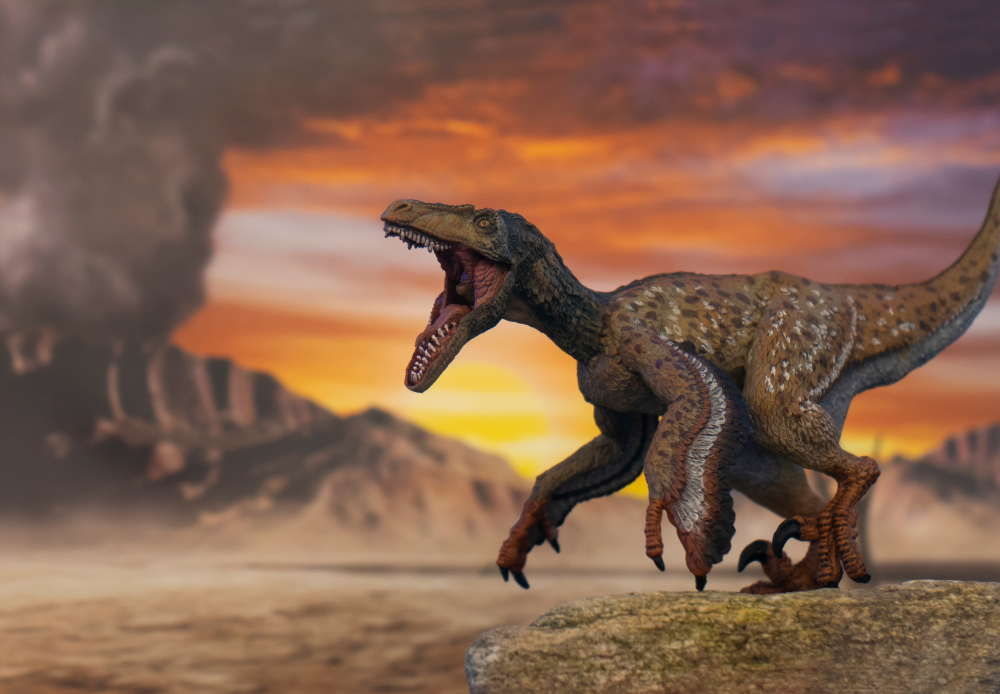For a group of animals that went extinct 60 million years ago, we know a remarkable amount about how dinosaurs lived, but what about how fast they could run? We’ve all seen the depictions in Jurassic Park of velociraptors chasing down humans with ease, but what was the fastest dinosaur?
Ascertaining dinosaur behavior generally involves a combination of approaches, because it’s rare that an activity gets preserved in the fossil record. One exception is the nest brooding of the wrongly accused “egg thief” Oviraptor, which was actually a dedicated parent (and probably fast on its feet). Track marks are one way to ascertain behavior, for example, but do any on Earth capture their speed?
What was the fastest dinosaur?
We don’t know which dinosaur was the fastest, at least, not for absolute certain, but we do have some idea of which groups were likely to have been among the fastest. One heavily considered candidate was Ornithomimosauria, a group of dinosaurs that looked a bit like the modern-day ostrich.
The ostrich is the fastest flightless bird in the world today. With their light build, specialized gait, and incredible height – up to 2.8 meters (9.2 feet) – they can clock between 55 to 70 kilometers (34 to 43 miles) per hour.
One anatomical feature that can indicate the speed of an animal is the length of its thigh and shin, as we see in leggy ostriches, and this can be used in a model to estimate how fast dinosaurs were. According to London Natural History Museum dinosaur researcher Dr David Button, such estimates put Velociraptor at around 40 kilometers (25 miles) per hour, at least in short bursts.

Velociraptor probably wasn’t the fastest dinosaur.
Image credit: Noiel/ hutterstock.com
“’It would have been quite fast by dinosaur standards – rather fortunate given its name means quick or swift – but not the fastest,” said Button. “That accolade goes to the ornithomimosaurs, which had very long shins and are thought to have been able to run as fast as the ostriches they resemble.”
Known as the “bird mimics,” Ornithomimosauria have often been cited as the top contenders for the fastest dinosaurs, with the Encyclopedia of Alabama estimating speeds of 48 kilometers (30 miles) per hour, but it’s a very difficult record to ascertain. That’s partly due to the evidence we have to work from when trying to establish how fast dinosaurs were, because it’s likely several theropod species were pretty speedy, but telling their tracks apart is also pretty difficult.
How fast were dinosaurs? Trackways
Trackways are one way to investigate how fast dinosaurs were moving, as by looking at a sequence of footprints left by one individual, you can make a rough estimate based on the footfall and size of the feet. According to the University of California Museum of Paleontology, the fastest dinosaur speed according to trackways was 43.5 kilometers (27 miles) per hour, which puts whatever creature it was about neck-to-neck with Usain Bolt.
So what dinosaur is about to chase down the world’s speediest human? We don’t know. A lot of dinosaur footprints look the same within their groups, so identifying the owner from trackways alone isn’t something we can do with great confidence.
Another problem is that trackways preserve best on soft ground, and if you’ve ever played soccer in a muddy field, you’ll know that’s not the best set of conditions for running your fastest. Therefore, they only give us a limited view of dinosaur speeds. Put that same dinosaur on a professional track and who knows? Maybe it would leave Bolt in the dust.
How fast were dinosaurs? Building computer models
If looking at trackways isn’t your thing, you might be interested in a study that used an evolutionary robotics approach to model how fast dinosaurs may have been able to run based on what we know of their anatomy. It involves creating musculoskeletal computer models that could be used to predict the speeds of three living bipedal species and five extinct ones.
Out of the living emu, ostrich, and human, versus the extinct Compsognathus, Velociraptor, Dilophosaurus, Allosaurus, and Tyrannosaurus, the fastest dinosaur was Compsognathus. Fans of Jurassic Park may remember the pesky little “compies” that rip apart a small girl on the beach, so that would’ve been a lot of fun if they were still alive today.
If you can’t run as fast as Usain Bolt and the thought of being chased down by a dinosaur is making you nervous, the good news is that not all of them were so light on their feet. You could probably “outrun” T. rex with a brisk stroll.
Source Link: What Was The Fastest Dinosaur?